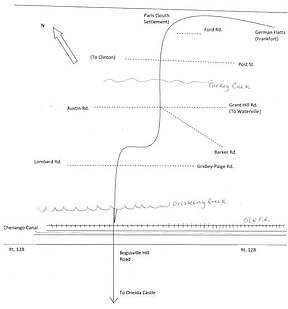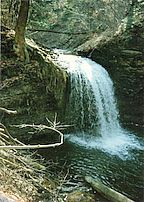The Town of Marshall was originally part of Tryon County, but morphed into Montgomery County, then to Herkimer County, to Oneida County in 1798; and then to the Town of Paris from 1792-1827 to the Town of Kirkland in 1827. We finally came into our own in 1829 as the Town of Marshall, named in honor of Supreme Court Justice John Marshall (1801-1835). All this is to explain the Moyer Road and how it came to be part of the Town of Marshall history.
The Moyer (or Military) Road, ran south-westerly from German Flatts (Frankfort), through Paris Hill (South Settlement) and Sauquoit, to Bogusville Hill Road and beyond. If you place a ruler on a road map from Frankfort to Bogusville Hill Road, it is practically in a straight line "as the crow flies." It undoubtedly originated as an Indian trail, but was also used by settlers who believed soldiers, led by a General Moyer, traveled this trail, hence the name.

However, no such general can be found to have existed. More likely, the name came from a Dutchman named Moyer who ran a tavern on the trail south of Utica. It is further theorized that on April 19, 1799, a Col. Goosen Van Schiack and a detachment of 55 men used this trail to raid the Onondaga Indians. However, historical accounts differ: their route was via Fort Stanwix. Also, early settlers claimed that Gen. John Sullivan led his troops over this road to massacre Indians to the west. He is supposed to have reconstructed sections with logs found nearby, as he advanced and camped just east of the Oriskany Creek near Bogusville, while his men attempted to erect a bridge over what they termed the Oriskany River. This cannot be verified, but if Samuel Kirkland was their chaplain and the Brothertown Indians their guide, as is alleged, this would be interesting indeed! It's more plausible that Moyer Road was part of the route taken by Sir John Johnson and his troops when they retreated to Canada in 1780 after raids on several Mohawk Valley settlements.

On the part of the trail travelling west from Post Street, called Concanon Road, later changed to Maxwell Road, is the site of an ancient Indian campground, where the Brotherton, Stockbridge and Oneida rested after a day's journey. In her notes, former historian Dorothy McConnell remembered that her ancestors collected what they thought were arrowheads from the area, until they were examined by a Dr. Grayson of Hamilton College, who explained that they were actually spear points thousands of years old and used before the invention of the bow and arrow.
The trail ran down a steep ravine by Turkey Creek, named because the wild turkeys found in this area by settlers and Indians. The bottom of the ravine was also known as Moyers Hole, and was another resting place where travelers watered their horses, probably in Turkey Creek.
Further down the trail was what was known to early settlers as Whitney Corners — later Lumbard Road — past the abandoned Peck Road, which led to Hanover, a bustling place until around 1837, when the Chenango Canal opened.
The trail went on past the intersection of Grant Hill Road and Austin Road, then down past Gridley Paige Road and over Oriskany Creek. At that point an Iroquois Indian settlement was established, and legend has it that it was here that Col. Heinrick Staring was brought after being captured by Indians during the Revolutionary War. It is said he escaped in the dead of night as his captors slept, ran into the woods and swam downstream in Oriskany Creek, and eventually made his way to Fort Stanwix.
The trail continued to Bogusville Hill Road, so named because of the manufacture and distribution of counterfeit coins by a man named Hurd who was ostensibly fabricating silver spoons. On Bogusville Hill Road is an inaccessible Brothertown Indian cemetery, which is believed to be the burial place of Samson Occom, leader of the Brothertowns. The Moyer, or Military, Road continued up Bogusvillle Hill to Knoxboro and Munnsville, and on to Oneida Castle. The Brothertown Indians, who didn't completely settle until after the Revolutionary War, seldom traveled the trail eastward, but sometimes used it to travel to Stockbridge.
Little is left of that trail of antiquity today other than geographical landmarks, but one can imagine what the Moyer or Military Road must have been like all those years ago, and can appreciate how it was a boon to travelers in those times.
